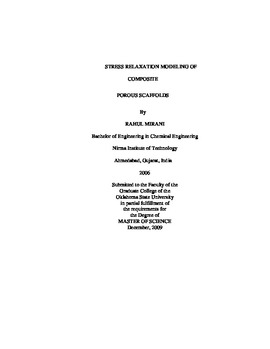| dc.contributor.advisor | Madihally, Sundarajan V. | |
| dc.contributor.author | Mirani, Rahul | |
| dc.date.accessioned | 2014-04-16T03:07:29Z | |
| dc.date.available | 2014-04-16T03:07:29Z | |
| dc.date.issued | 2009-12-01 | |
| dc.identifier.uri | https://hdl.handle.net/11244/9648 | |
| dc.description.abstract | Many synthetic and xenogenic natural matrices have been explored in tissue regeneration, however, they lack either mechanical strength or cell colonization characteristics found in natural tissue. Moreover natural matrices such as small intestinal submucosa (SIS) lack sample to sample homogeneity, leading to unpredictable clinical outcomes. As a result forming synthetic matrices from biodegradable polymers is considered an attractive alternative. In this regard blending two or more polymers is a good option to develop scaffolds with a wide range of physiochemical properties and cellular interactions. Majority of the studies in tissue engineering concerning scaffold materials are focused on cell culture studies, measuring porosity and understanding the degradation characteristics of scaffolds. Mechanical analysis of biomaterials especially the viscoelastic analysis remains largely unexplored. The objective of this study was to evaluate the viscoelastic characteristics of potential scaffolds to be used in tissue regeneration. PLGA based composite scaffold was used as a model structure for evaluating viscoelastic stress relaxation characteristics by performing experiments of the "Ramp-and-Hold" type. Quasi Linear Viscoelastic (QLV) model, the most widely used model in biomechanics, was used to quantify the viscoelastic behavior of the scaffold in terms of the physiological model parameters. Also, the viscoelastic characteristics of the composite scaffold were evaluated in tandem with the natural matrix SIS. "Ramp-and-Hold" experimental results showed that the PLGA composite structure relaxes better than SIS. This was in concurrence with the values of the phenomenological QLV model parameters. Also, the PLGA composite was found to be strain rate softening compared to the strain rate hardening of SIS. Curve-fitting results revealed that the model successfully predicted the experimental data for SIS with less than 2% relative error. For the PLGA composite, though the model correctly predicted the trend observed in the experimental data, it failed to fit the data correctly. This can be attributed to the numerous assumptions involved in the derivation of the QLV model. This warrants the need for a robust, phenomenological model based purely on the material behavior devoid of assumptions for assessing the viscoelastic properties of synthetic scaffolds. | |
| dc.format | application/pdf | |
| dc.language | en_US | |
| dc.publisher | Oklahoma State University | |
| dc.rights | Copyright is held by the author who has granted the Oklahoma State University Library the non-exclusive right to share this material in its institutional repository. Contact Digital Library Services at lib-dls@okstate.edu or 405-744-9161 for the permission policy on the use, reproduction or distribution of this material. | |
| dc.title | Stress Relaxation Modeling Of Composite Porous Scaffolds | |
| dc.type | text | |
| dc.contributor.committeeMember | Rhinehart, R.Russell | |
| dc.contributor.committeeMember | Johannes, Arland | |
| osu.filename | Mirani_okstate_0664M_10747.pdf | |
| osu.college | Engineering, Architecture, and Technology | |
| osu.accesstype | Open Access | |
| dc.description.department | School of Chemical Engineering | |
| dc.type.genre | Thesis | |
| dc.subject.keywords | plga composite | |
| dc.subject.keywords | quasi linear viscoelastic model | |
| dc.subject.keywords | scaffolds | |
| dc.subject.keywords | sis | |
| dc.subject.keywords | stress relaxation | |
| dc.subject.keywords | viscoelasticity | |
